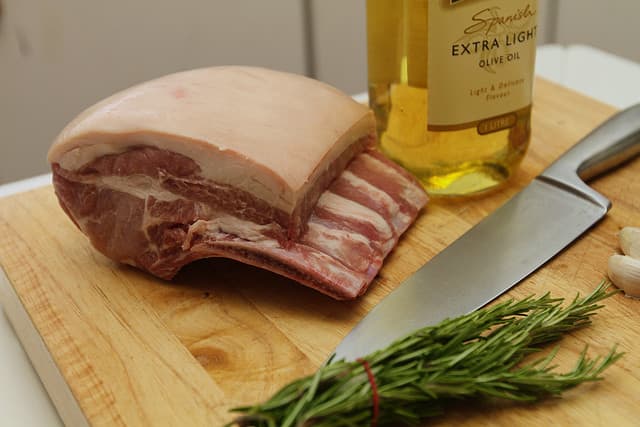How to Cook a Bone-In Pork Loin Roast
John D Lee is a chef and restauranteur living and working in Chiang Mai, Thailand. He's always loved to cook.
Breaking away from tradition, I decided to forego turkey for this year’s Christmas dinner and do a bone-in pork loin roast instead. Since the overwhelming majority of recipes I consulted in planning the meal called for boneless pork roasts, it took a little research to put together a winning plan for the meal.
Anyway, to save you the same trouble, here’s an easy (2 day) plan for making a fantastic, show-stopping bone-in loin roast.
How to Cook a Bone-In Pork Rib Roast
The Steps:
- Procure one from your butcher. While Frenched bones (bones with meat cleaned away) can make an elegant presentation, this presentation comes at the cost of the tastiest meat on the whole roast. In my opinion, skip the clean French roast look and get a meaty roast with all that delicious, succulent, sparerib meat still on the bone.
- Brine the meat for 10 hours.
- Take the meat out of the brine and let it rest overnight.
- Season the roast and let the meat come up to room temperature for an hour or so on the counter prior to cooking.
- Roast the meat in a 350 degree oven until the interior is at 150f.
- Let the roast rest for about 20 minutes before carving.
- Enjoy a fantastic dinner.
Ingredients
- 1 bone-in pork roast—about 7 or 8 pounds or bigger
- A bunch of garlic
- Kosher salt
- Some honey
- Freshly cracked pepper and whole peppercorns
- A little dried thyme and a couple of bay leaves
- Some fresh rosemary
- A little extra virgin olive oil
Instructions
- The morning of the day before you plan on eating the roast, make up your brine. You want to make a brine with a 5% salinity—so measure out 4 liters of water to a pot and add to this 200 grams of kosher salt (50 grams per liter). With the side of your knife, flatten about 20 cloves of garlic and add this to the pot with 2 Tbls of whole peppercorns, ¼ cup of honey, a couple of bay leaves and 1 tsp of dried thyme. Bring this just to a boil and then let it cool, first for a bit on the counter top and then in the fridge. Once cooled, add in the pork roast and keep in the refrigerator to salty percolate for ten hours. (Always remember that it’s infinitely better to under-brine than over-brine! A too long brining will make your meat unpleasantly salty)
- After 10 hours, dump off all of the brine and then transfer the pork back the fridge to rest until almost time to cook. This resting period after brining, while not totally essential, helps to ensure that the seasoning from the brine is evenly distributed through the whole roast.
- About 3 hours before dinner time, take the meat out of the fridge and let it sit on the counter. The idea here is to let the roast shake off some if its fridge chill before you start the cooking process. This is actually good practice for cooking any kind of meat, as the closer to room temperature you start cooking at, the the less likely you are to overcook the exterior of the meat before getting the interior up to a desired temperature.
- Chop up about 6 cloves of garlic and mix this with 4 tsps of fresh rosemary, finely minced. Cut little slits with a paring knife at intervals into the meat and stuff these with the minced garlic and rosemary. Rub the whole roast with a little olive oil and then give it all a generous sprinkling of freshly cracked pepper (no more salt is needed, since its already been brined).
- Let this sit on the counter for an hour, and at some point during this hour, get your oven preheated up to 350f.
- After an hour, pop your roast into a roasting dish and transfer it into the oven to cook. This will take between an hour and 2 hours—depending on the exact heat of your oven, and more importantly, on the diameter of the roast. After an hour or so, check the deepest interior of the roast with an instant read thermometer. Take the roast out of the oven once it reaches 150 and then cover it with foil to rest on the counter for at least 20 minutes before carving. (150 will give you a roast with almost no pink inside, as the temperature will continue to rise inside the meat during the resting period. If you like your roast a little pink, you can take the meat out at 145.)
Enjoy!
















